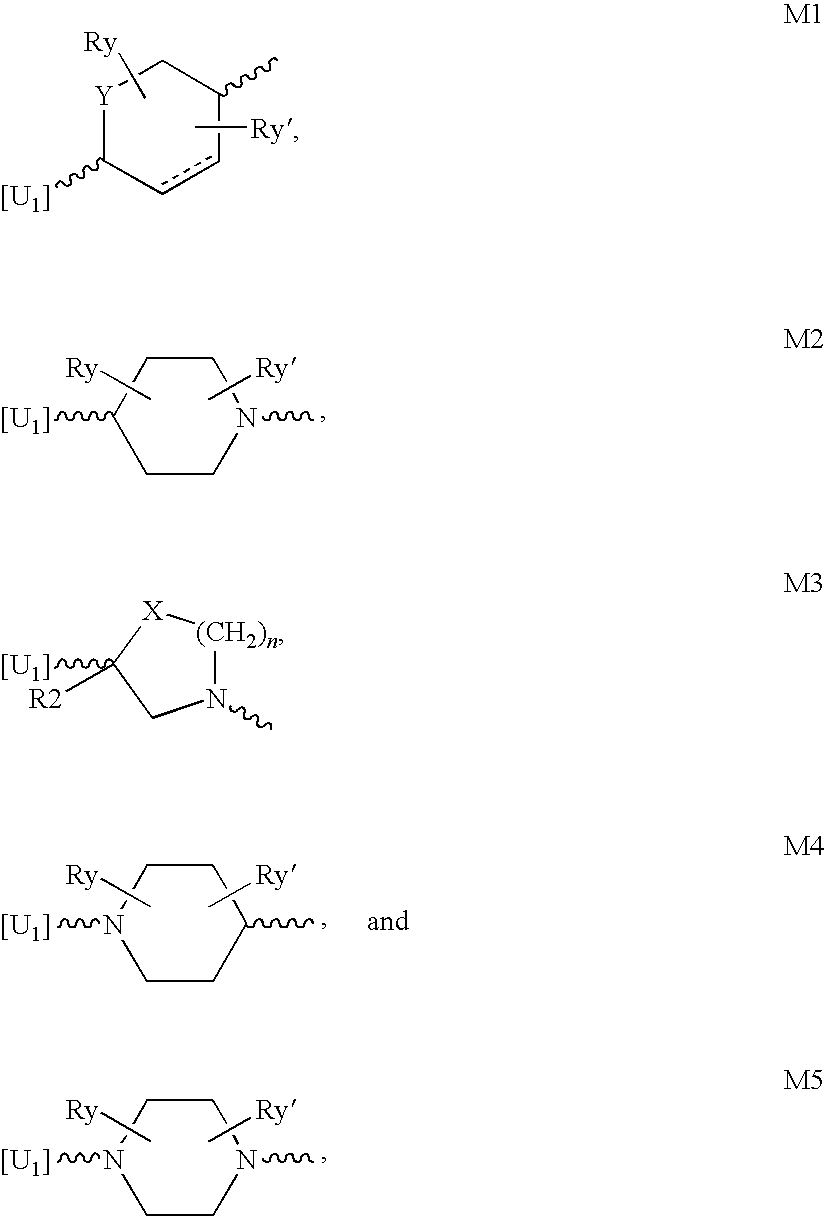Compounds for the treatment of multi-drug resistant bacterial infections
a multi-drug resistant, bacterial infection technology, applied in the direction of antibacterial agents, drug compositions, organic chemistry, etc., can solve the problems of resistance strains of gram-positive pathogens such as methicillin- and staphylococcus aureus-
- Summary
- Abstract
- Description
- Claims
- Application Information
AI Technical Summary
Benefits of technology
Problems solved by technology
Method used
Image
Examples
example 1
1-(2-{4-[(2,3-Dihydro[1,4]dioxino[2,3-c]pyridin-7-ylmethyl)amino]piperidin-1-yl}ethyl)-7-methoxyquinolin-2(1H)-one
[0463]A solution of 1-[2-(4-aminopiperidin-1-yl)ethyl]-7-methoxyquinolin-2(1H)-one (Intermediate 1, crude, 60 mg, 0.20 mmol) and 2,3-dihydro[1,4)dioxino[2,3-c]pyridine-7-carbaldehyde (WO 2004 / 058144) (33 mg, 0.20 mmol) in dry chloroform / methanol (5 mL, 1:1) was heated over 3 Å molecular sieves at 70° C. for 3 hours. The reaction mixture was cooled to 0° C., and sodium triacetoxy borohydride (127 mg, 0.6 mmol) was added. The resulting reaction mixture was stirred at room temperature for 30 minutes and then was filtered through a 0.45 μm membrane and concentrated to dryness under reduced pressure. The residue was taken up in dichloromethane (50 mL) and saturated aqueous sodium hydrogen carbonate solution (5 mL). The pH of the aqueous phase was adjusted to a pH of 10 with 1M aqueous sodium hydroxide solution. The aqueous phase was back extracted twice with dichloromethane (...
example 2
1-(2-{4-[(2,3-Dihydro[1,4]dioxino[2,3-c]pyridin-7-ylmethyl)amino]piperidin-1-yl}ethyl)-7-methoxyquinolin-4(1H)-one
[0487]A solution of 1-[2-(4-aminopiperidin-1-yl)ethyl]-7-methoxyquinolin-4(1H)-one (Intermediate 8, 60 mg, 0.20 mmol) and 2,3-dihydro[1,4]dioxino[2,3-c]pyridine-7-carbaldehyde (WO 2004 / 058144) (33 mg, 0.20 mmol) in dry chloroform / methanol (5 mL, 1:1) was heated over 3 Å molecular sieves at 70° C. for 3 hours. The reaction mixture was cooled to 0° C., and sodium triacetoxyborohydride (127 mg, 0.6 mmol) was added and the resulting mixture was stirred at room temperature for 30 minutes. The mixture was then filtered through a 0.45 tun membrane, acidified with conc. HCl to pH 1 and concentrated to dryness under reduced pressure. The residue was taken up in dichloromethane (50 mL) and saturated aqueous sodium hydrogen carbonate solution (5 mL). The pH of the aqueous phase was adjusted to pH10 with 1M aqueous sodium hydroxide solution. The aqueous phase was back extracted twic...
example 3
Methyl 1-(2-{4-[(2,3-dihydro[1,4]dioxino[2,3-c]pyridin-7-ylmethyl)amino]piperidin-1-yl}ethyl)-6-methoxy-1H-indole-2-carboxylate
[0502]A solution of methyl 1-[2-(4-aminopiperidin-1-yl)ethyl]-6-methoxy-1H-indole-2-carboxylate (Intermediate 12, 200 mg, 0.60 mmol) and 2,3-dihydro[1,4]dioxino[2,3-c]pyridine-7-carbaldehyde (WO 2004 / 058144) (100 mg, 0.60 mmol) in dry chloroform / methanol (10 mL, 1:1) was heated over 3 Å molecular sieves at 70° C. for 3 hours. The reaction mixture was cooled to 0° C., sodium triacetoxy borohydride (384 mg, 1.8 mmol) was added and the resulting mixture was stirred at room temperature for 30 minutes. The reaction mixture was filtered through a 0.45 μm membrane and concentrated to dryness under reduced pressure. The residue was taken up in dichloromethane (150 mL) and saturated aqueous sodium hydrogen carbonate solution (30 mL), the aqueous phase back extracted once with dichloromethane (70 mL) and the combined organic phases were dried over sodium sulfate. Chro...
PUM
| Property | Measurement | Unit |
|---|---|---|
| antibacterial resistance | aaaaa | aaaaa |
Abstract
Description
Claims
Application Information
 Login to View More
Login to View More - R&D
- Intellectual Property
- Life Sciences
- Materials
- Tech Scout
- Unparalleled Data Quality
- Higher Quality Content
- 60% Fewer Hallucinations
Browse by: Latest US Patents, China's latest patents, Technical Efficacy Thesaurus, Application Domain, Technology Topic, Popular Technical Reports.
© 2025 PatSnap. All rights reserved.Legal|Privacy policy|Modern Slavery Act Transparency Statement|Sitemap|About US| Contact US: help@patsnap.com



